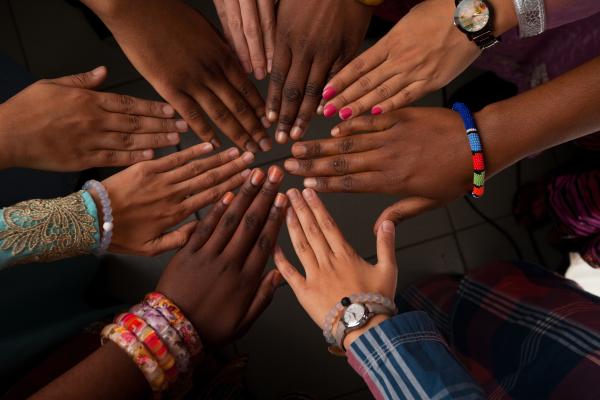GBV AoR Helpdesk Annual Report 2022
This annual report summarises the activity of the GBV AoR Helpdesk for the year 2022, including the type of queries the Helpdesk has responded to and the regions it has supported.
 Our global Gender-Based Violence (GBV) team provides strategic technical support to actors across the GBV ecosystem from donors to community-level women-led organisations. We are a multi-disciplinary team delivering programme design and implementation support, advocacy, research reports, MEL and helpdesk services.
Our global Gender-Based Violence (GBV) team provides strategic technical support to actors across the GBV ecosystem from donors to community-level women-led organisations. We are a multi-disciplinary team delivering programme design and implementation support, advocacy, research reports, MEL and helpdesk services.
Our team aspires to apply our feminist principles in all our work and to support sustained and transformative change. We partner with diverse stakeholders and we take an intersectional approach to our work on GBV prevention and response across development and humanitarian contexts.
Our work includes primary prevention programming, community-level response to GBV and SEAH, school-related GBV, GBV in Emergencies, Technology-Facilitated GBV, Violence against LGBTQI+ communities, and GBV in Climate and Economic programming.
Read more about our current work or search our extensive GBV Resource Library below.
This annual report summarises the activity of the GBV AoR Helpdesk for the year 2022, including the type of queries the Helpdesk has responded to and the regions it has supported.
This guidance note has been generated in response to a request for practical guidance to GBV caseworkers in the Latin America region who have been asked to support women in detention settings and prisons who have experienced intimate partner violence (IPV) and who continue to be at risk of intimate partner violence whilst in detention/prison and upon release from detention/prison. This publication is likely, however, to have wider benefit to GBV caseworkers working in other humanitarian settings.
This learning brief focuses on technology-facilitated gender-based violence (TFGBV) affecting publicly visible women in humanitarian and emergency contexts. The learning brief begins with an overview of TFGBV prevalence, then focuses on risk groups of publicly visible women and how TFGBV impacts them, including women parliamentarians and politicians, journalists, women human rights defenders and activists. It moves on to provide examples of good practice in working with these different groups of publicly visible women to prevent and respond to their particular risks of TFGBV.
This learning brief is meant to serve as a tool for donors and GBV programmers alike, to support discussions around what we know already know about the scope of GBV in humanitarian settings; why collecting GBV prevalence data is not a priority in humanitarian settings; and which data sources donors and practitioners can safely rely on to inform decision-making on GBV programming.
Este resumen de aprendizaje es parte de una serie de productos de conocimiento elaborados por el servicio de ayuda técnica del Área de Responsabilidad de la violencia basada en el género (AoR de VBG). Las colegas del Fondo de Población de las Naciones Unidas (UNFPA) han colaborado en el desarrollo y finalización del contenido.
Cette note d'apprentissage fournit un aperçu préliminaire des principes et approches de base du traitement de santé mentale éclairé par les féministes pour les survivantes de violence basée sur le genre (VBG), en particulier les survivantes de violence sexuelle qui présentent des symptômes de stress post-traumatique ou d'autres problèmes de santé mentale qui ne peuvent pas être résolus par une gestion de cas plus généralisée de VBG et / ou un soutien psychosocial.
يهدف هذا الموجز التعليمي إلى أن يقوم مقام أداة للجهات المانحة ومعُدّات البرامج المتعلقة بالعنف القائم على النوع الاجتماعي على حد سواء، بهدف دعم المناقشات حول ما نعرفه حاليًا عن نطاق العنف القائم على النوع الاجتماعي في الأوضاع الإنسانية؛ ولماذا لا يمثل جمع بيانات انتشار العنف القائم على النوع الاجتماعي أولوية في الأوضاع الإنسانية وكذلك مصادر البيانات التي يمكن للجهات المانحة والممارِسات الاعتماد عليها بأمان لإثراء عملية اتخاذ القرار بشأن برامج العنف القائم على النوع الاجتماعي.
Este informe explicativo tiene como objetivo servir de herramienta a donadores y administradores de programas de ayuda para víctimas de GBV para apoyar los debates sobre lo que ya sabemos acerca del alcance de la GBV en los entornos humanitarios, por qué la recopilación de datos de prevalencia de la GBV no es una prioridad en los entornos humanitarios y en qué fuentes de datos pueden confiar los donantes y los profesionales para informar la toma de decisiones en los programas de ayuda para víctimas de GBV.
تسعى سلسلة التعلم هذه إلى: 1) بناء معارف أساسية حول العنف القائم على النوع الاجتماعي عبر التكنولوجيا؛ 2) تسليط الضوء على الاستراتيجيات الحالية لمنع العنف القائم على النوع الاجتماعي عبر التكنولوجيا والاستجابة له والتي يمكن مواءمتها لتُستخدم في الحالات الطارئة والسياقات الهشة؛ 3) اقتراح إجراءات ذات أولوية والتي يجب أن يتخذها مختلف أصحاب المصلحة للبدء في حلّ المشكلة.
يقدم هذا المورد خيارات لتكييف إدارة حالات العنف القائم على النوع الاجتماعي في سياق جائحة كوفيد-19 حتى تتمكن الناجيات من الاستمرار في الوصول إلى خدمات آمنة وسرية وتلقيها.